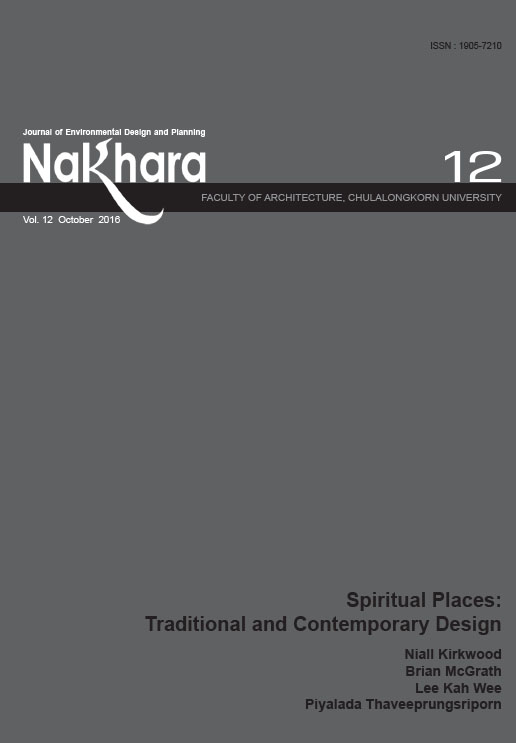‘Public’ Prayer Rooms of Contemporary Bangkok
Main Article Content
Abstract
This paper investigates the exclusivity of Muslim prayer rooms found distributed throughout urban Bangkok. Although the prayer room can hardly be considered domestic, its existence is not really ‘public’ either. Increasingly, this little worship space is accommodated in some public facilities owned by state organizations and private corporations. In this paper the prayer room is examined in three interrelated scales: the geographical network, the placement of the room within a facility and the interior. The examination reveals inscribed body-place relationships which are conceived specifically to different projected images of each place and different social categorizations of Muslim users.
Article Details
How to Cite
Ardrugsa, W. (2016). ‘Public’ Prayer Rooms of Contemporary Bangkok. Nakhara : Journal of Environmental Design and Planning, 12, 85–104. retrieved from https://ph01.tci-thaijo.org/index.php/nakhara/article/view/103520
Section
Review Articles
References
Haung Lamat Prajum Hang Prajum Sanambin [Prayer Rooms in Shopping Malls and Airports]. (2009). Retrieved from http://www. annisaa.com/forum/index.php?topic= 1182.0
Bhabha, H. (1994). The location of culture. London: Routledge.
Butler, J. (1990). Gender Trouble, Feminism and the Subversion of Identity. London: Routledge.
De Certeau, M. (1984). The practice of everyday life (Steven Rendal, Trans.). Berkeley, Los Angeles: University of California Press.
Massari P. (1995, July-August). Garanee Seuksa Rong Payaabarn Mutsalim Nai Prathet-Thai [the Muslim Hospital in Thailand: A case study]. Santichon Magazine, 27-35.
Kampong Newspaper. (2009, September), pp. 23.
Lefebvre H. (1991). The production of space (Donald Nicholson-Smith, Trans.). Oxford: Blackwell.
Sibley, D. (1995). Geographies of exclusion. London: Routledge
Bhabha, H. (1994). The location of culture. London: Routledge.
Butler, J. (1990). Gender Trouble, Feminism and the Subversion of Identity. London: Routledge.
De Certeau, M. (1984). The practice of everyday life (Steven Rendal, Trans.). Berkeley, Los Angeles: University of California Press.
Massari P. (1995, July-August). Garanee Seuksa Rong Payaabarn Mutsalim Nai Prathet-Thai [the Muslim Hospital in Thailand: A case study]. Santichon Magazine, 27-35.
Kampong Newspaper. (2009, September), pp. 23.
Lefebvre H. (1991). The production of space (Donald Nicholson-Smith, Trans.). Oxford: Blackwell.
Sibley, D. (1995). Geographies of exclusion. London: Routledge

